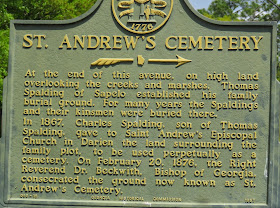Meet Altie, the Altamaha-ha, or sea creature alleged to inhabit the myriad network of streams and abandoned rice fields near the mouth of the Altamaha River around Darien, Georgia. This likeness is found in Darien's Visitor Center.
We camped at Altamaha Regional Park,
On the banks of the Altamaha River. If you put your kayak in here, you can paddle all the way to the sea at Darien in one day. And maybe you will be lucky enough to encounter "Altie" on the way.
I did get on the river to explore a little, but we decided to drive to Darien.
Just south of Darien we passed one of those old rice plantations. Butler Island Plantation was one of the largest plantations in the South. Beginning in the 1790s, Major Pierce Butler planted the land on the Altamaha Delta, which provided perfect conditions for growing rice. The chimney is a steam-powered rice mill.
The Pierce Butler mentioned here is the original Butler's grandson who returned after the Civil War.
The plantation site is now owned by the Georgia Conservancy, and the land (excluding the house) is open to the public for picknicking, boating, and birding.
Across the highway was this historic marker near the site of another rice plantation.
Our first stop in Darien was the waterfront. This corner was the scene of commercial activities during the antebellum period. The circa 1820 two-story cotton warehouse and ship chandlery survived the burning of Darien in 1863 by raiding Union forces. It became the mercantile establishment of Adam Strain from 1870-1897. A portion of the structure housed the Darien Bank from 1913-1961. The stuccoed tabby building is the oldest commercial building in Darien.The circa 1810-1830 tabby ruins below the building are remains of warehouses, shops, and taverns which served the timber and shipping industries of Darien.
Later we returned to the waterfront for lunch at Skippers, recommended by one of our tour guides.
Outside decor at Skippers.
Nan had flounder!
My crab cake sandwich was great!
I think Nan liked the flounder too.
This is the Waterfront Park
We will miss the annual "Blessing of the Shrimp Fleet", an event that takes place next weekend.
This live oak tree clings to an old tabby wall.
Darien is still a busy port.
Darien was first settled by Scottish Highlanders.
Another stop on our driving tour was the old jailhouse, circa 1888.
The building now houses an art gallery and provides art classes, but the old cells upstairs have been preserved as a museum.
Inside one of the cells.Behind the jail is the historic First African Baptist Church. The 1822 building was burned during the 1863 Union raid, but was later rebuilt.
Not far away is the Grant house, the only residence to survive the burning of Darien. It was eventually owned by African American educator James Grant, and still remains in the Grant family.
Behind the church is Columbus Square. The gazebo marks the location of the old depot, completed in 1895. The depot was later moved to the waterfront and ultimately destroyed by fire.
Just the name Ashantilly makes you curious. This old plantation house is a little off the beaten path, but its story is well worth the effort to find it.The sign, like the house, is in need of repair and preservation. It is an ongoing project of Ashantilly Center, Inc. the non-profit beneficiary of the estate.
Ashantilly was one of two homes built by plantation owner Thomas Spalding. One was on the plantation on Sapelo Island, and this one was built on the mainland where it would be easier to conduct his business. The original building dates from 1820.
After Spalding's death the property changed hands and was ultimately purchased by the Haynes family in 1918, when Bill Haynes was 10 years old. After attending art school in New York, Bill returned home in 1936. A year later, a fire gutted the interior. The original tabby walls were saved.
In 1939 Bill Haynes began restoration of the home. He located and purchased doors, mantels, and other period pieces in salvage yards in Savannah and Charleston.
His restorative work was interrupted when called away to serve in World War II.
Upon his return he attended school on the GI Bill and began a career of printing. He returned to Ashantilly with his new bride and established The Ashantilly Press.
His two sisters also returned to live at Ashantilly. The restoration and preservation continued, as did the growing printing business.
Bill's first printing press is on display as well as many of his books and art works produced.
Bill and his sister, Anne Lee, donated the house and property to Ashantilly Center, Inc. to create a job training and community center for the people of coastal Georgia. Bill Hayes died in 2001 at age 93. His legacy is still being sorted, categorized, and preserved at Ashantilly.
Inside the upstairs stairwell the original tabby walls can still be seen.
Some of Haynes drawings.
A drawing of Ft. king George done on silkscreen.
A sketch of the original Ashantilly house of Thomas Spalding.
This antique "biscuit beater" was interesting….used to make hardtack.
The exterior rear of the house.
The steps may lead to what was the original kitchen.
The Ashantilly Press
Adjacent to the property is the Thomas Spalding family burial ground, now the St. Andrews Cemetery. We didn't search out the graves because we were on our way to a seafood lunch at Skippers.
The sign outside Ashantilly says tours by appointment. We didn't have an appointment, so I must give thanks to the gracious workers who stopped what they were doing to give us a guided tour of this remarkable home.
Of course there were more places we didn't have time to see…another visit to Darien will be needed.



















































No comments:
Post a Comment
Due to recent spam in comments, all new comments will be moderated and approved before publishing.